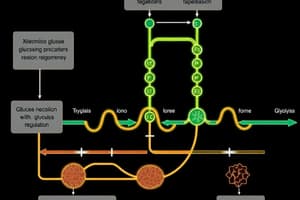Podcast
Questions and Answers
Glycolysis is the metabolic pathway that converts glucose into ____________.
Glycolysis is the metabolic pathway that converts glucose into ____________.
False (B)
How many net molecules of ATP are generated during glycolysis?
How many net molecules of ATP are generated during glycolysis?
False (B)
What are the three key enzymes of glycolysis?
What are the three key enzymes of glycolysis?
False (B)
Glycolysis occurs in the ____________ and is oxygen-independent.
Glycolysis occurs in the ____________ and is oxygen-independent.
In cells lacking mitochondria and/or adequate oxygen supply, glycolysis is the ____________ process to produce ATP from glucose.
In cells lacking mitochondria and/or adequate oxygen supply, glycolysis is the ____________ process to produce ATP from glucose.
Which enzyme catalyzes the transfer of pyruvate to lactate?
Which enzyme catalyzes the transfer of pyruvate to lactate?
Glycolysis can be broken down into two main phases: the energy-requiring phase and the _____ phase.
Glycolysis can be broken down into two main phases: the energy-requiring phase and the _____ phase.
Glycolysis takes place in the _____ of a cell.
Glycolysis takes place in the _____ of a cell.
The fate of pyruvate depends on the presence or absence of _____ and oxygen in the cells.
The fate of pyruvate depends on the presence or absence of _____ and oxygen in the cells.
Glycolysis is the process in which glucose is broken down to produce _____ .
Glycolysis is the process in which glucose is broken down to produce _____ .
Where is ATP used in glycolysis? First Half of Glycolysis (Energy-Requiring Steps) In the first half of glycolysis, two adenosine triphosphate (ATP) molecules are used in the phosphorylation of _____ .
Where is ATP used in glycolysis? First Half of Glycolysis (Energy-Requiring Steps) In the first half of glycolysis, two adenosine triphosphate (ATP) molecules are used in the phosphorylation of _____ .
The final output or end product of Glycolysis includes two molecules of pyruvate, ATP, NADH, and _____ .
The final output or end product of Glycolysis includes two molecules of pyruvate, ATP, NADH, and _____ .
What is the first enzyme in glycolysis? The first step of glycolysis is the conversion of glucose to _____ .
What is the first enzyme in glycolysis? The first step of glycolysis is the conversion of glucose to _____ .
Is glycolysis aerobic or anaerobic?
Is glycolysis aerobic or anaerobic?
Does glycolysis produce CO2?
Does glycolysis produce CO2?
What are two advantages of glycolysis?
What are two advantages of glycolysis?
Glycolysis occurs in the mitochondria of a cell.
Glycolysis occurs in the mitochondria of a cell.
Glycolysis takes place in the mitochondria of a cell.
Glycolysis takes place in the mitochondria of a cell.
The enzyme phosphofructokinase is involved in the priming stage of glycolysis.
The enzyme phosphofructokinase is involved in the priming stage of glycolysis.
The investment phase of glycolysis involves the net creation of ATP and NADH molecules.
The investment phase of glycolysis involves the net creation of ATP and NADH molecules.
The transfer of pyruvate to lactate is catalyzed by the enzyme pyruvate kinase.
The transfer of pyruvate to lactate is catalyzed by the enzyme pyruvate kinase.
The final output of glycolysis includes carbon dioxide.
The final output of glycolysis includes carbon dioxide.
Glycolysis produces a total of four molecules of ATP per molecule of glucose.
Glycolysis produces a total of four molecules of ATP per molecule of glucose.
Glycolysis only occurs in aerobic organisms.
Glycolysis only occurs in aerobic organisms.
The splitting stage of glycolysis involves cleaving glucose into two phosphorylated 4-carbon compounds.
The splitting stage of glycolysis involves cleaving glucose into two phosphorylated 4-carbon compounds.
The first step of glycolysis involves the conversion of glucose to fructose-6-phosphate.
The first step of glycolysis involves the conversion of glucose to fructose-6-phosphate.
Lack of adequate oxygen supply can lead to an increase in aerobic respiration over glycolysis.
Lack of adequate oxygen supply can lead to an increase in aerobic respiration over glycolysis.
During glycolysis, one 6-carbon molecule of glucose is oxidized to produce one 3-carbon molecule of pyruvate.
During glycolysis, one 6-carbon molecule of glucose is oxidized to produce one 3-carbon molecule of pyruvate.
The energy-releasing phase of glycolysis occurs above the dotted line in the image.
The energy-releasing phase of glycolysis occurs above the dotted line in the image.
Glycolysis produces CO2 as one of its end products.
Glycolysis produces CO2 as one of its end products.
ATP is only used in the payoff phase of glycolysis.
ATP is only used in the payoff phase of glycolysis.
Glycolysis can continue on to the Krebs cycle and oxidative phosphorylation if oxygen is not present.
Glycolysis can continue on to the Krebs cycle and oxidative phosphorylation if oxygen is not present.
Flashcards are hidden until you start studying




